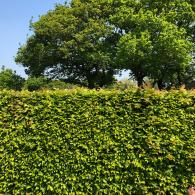Corylus Avellana Hazel
1. Add items to basket
2. Go to the basket
3. Enter your postcode in Delivery Price Check
Pot size: 3 Litres
Hedge Guide: 5 Plants/Mtr
Plant ID: 12346 64
View plant size:Pot size: 10 Litres
Hedge Guide: 3 Plants/Mtr
Plant ID: 11542 64
View plant size:Plant shape: Bush
Pot size: 20 Litres
Plant ID: 15710 2
View plant size:Plant shape: Full standard
Trunk height: 1.6-1.8 m
Trunk girth: 8-10 cm
Rootball - supplied without a pot
Plant ID: 12735 100
Plant shape: Bush
Pot size: 180 Litres
Plant ID: 14898 2
View plant size:To check delivery cost add your plants to basket, then you can type your postcode in our Quick Delivery Price Check.
Corylus Avellana, also known as Common Hazel, is a long-cultivated native variety which has great value to UK gardeners as a specimen tree or as a bushy hedging shrub. Its versatility makes it suitable for a variety of landscape plans. Hazels are native to the UK and across Europe, and have been cultivated since ancient times for their nuts and wood. Corylus avellana is the upright variety of hazel – as opposed to Corylus Avellana Contorta which is the twisted variety.
Corylus Avellana blooms very early in the season, sometimes before the new year, and is an extremely important early pollen source for bees. Both male and female flowers appear on the same tree, but it is the yellow male catkins that are prominent, hanging in clusters. The female flowers are followed by oval fruits which mature into nuts by autumn. It is necessary to plant more than one hazel for cross-pollination for nut production. The green, hairy round to oval leaves emerge early, turning yellow in the autumn.
Hardy throughout the UK and Europe, Corylus Avellana will grow to a height and spread of 4-8 metres over a period of 10 to 20 years. While a hazel plant can grow into a tree with a single stem, it is usually cut down by wildlife eating the tender stems, and develops into a bush with many branches. You can mimic that growth habit with annual pruning to create a dense, bushy hedging screen. Corylus Avellana is also often coppiced, and the wood used for many purposes, including firewood, pea sticks and bean poles. An unpruned hazel tree will live for 80 years, while a coppiced hazel can last for hundreds!
Plant hazel in moist but well-drained sand, loam, or chalk soil, preferably alkaline or neutral, in any exposed or sheltered situation in sun or part shade. It is not suited to coastal plantings.
Corylus Avellana is a natural choice for a wildlife or woodland garden, or in a mixed hedgerow. Its flexible stems make it a great candidate for training into a living fence. It also can be planted as a specimen tree in a small city garden, or as a small clump of bushes in an informal garden.
The long history of the cultivation of the hazel in the UK continues into today. This versatile, beautiful and useful plant can find a place in a city garden or the country landscape!















